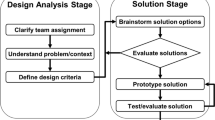Abstract
This is a cross-sectional study of 519 undergraduate engineering majors’ self-efficacy beliefs at a large, research extensive, Midwestern university. Engineering self-efficacy is an individual’s belief in his or her ability to successfully negotiate the academic hurdles of the engineering program. Engineering self-efficacy was obtained from four variables: self-efficacy 1, self-efficacy 2, engineering career outcome expectations, and coping self-efficacy. The four variables were analyzed using a repeated analysis of variance among levels of gender, ethnicity, years students had been enrolled in their engineering program, and transfer status. No significant differences in mean engineering self-efficacy scores were found by gender, ethnicity, and transfer status. However, significant interactions between gender and the subscales, ethnicity and the subscales, and transfer status and the subscales were found. Significant differences in mean engineering self-efficacy scores were found among years students had been enrolled in the program.



Similar content being viewed by others
References
Adelman C (1998) Women and men of the engineering path: a model for analysis of undergraduate careers. U.S. Department of Education and the National Institute for Science Education, Washington, DC
Bandura A (1986) Social foundations of thought and action: a social cognitive theory. Prentice-Hall, Englewood Cliffs
Bandura A (1997) Self-efficacy: the exercise of control. Freeman, New York
Betz N, Hackett G (1981) The relationship of career-related self-efficacy expectations to perceived career options in college women and men. J Couns Psychol 28(5):399–410. doi:10.1037/0022-0167.28.5.399
Bradburn EM (1995) Engineering gender roles: a self-efficacy model of occupational choice and persistence. Cornell U, US, 1
Brainard S, Carlin L (1998) A six-year longitudinal study of undergraduate women in engineering and science. J Eng Educ 87:369–375
Britner SL, Pajares F (2006) Sources of science self-efficacy beliefs of middle school students. J Res Sci Teach 43:485–499. doi:10.1002/tea.20131
Concannon J, Barrow L (2008) A cross-sectional study of engineering self-efficacy. Proceedings of the 2008 annual meeting of the american society of engineering education and exposition, 24 June 2008 (AC 2008-148). ASEE, Pittsburg
Goodman Research Group, Inc. (2002) A comprehensive evaluation in engineering programs. Retrieved on 5 July 2007, from http://www.grginc.com
Hackett G, Betz NE (1989) An exploration of the mathematics self-efficacy/mathematics performance correspondence. J Res Math Educ 20:261–273. doi:10.2307/749515
Hackett G, Betz NE, Casas J, Rocha-Singh IA (1992) Gender, ethnicity, and social cognitive factors predicting the academic achievement of students in engineering. J Couns Psychol 39:527–538. doi:10.1037/0022-0167.39.4.527
Johnson D, Stone D, Philliips T (2008) Relations among ethnicity, gender, beliefs, attitudes, and intention to pursue a career in information technology. J Appl Psychol 38:999–1022. doi:10.1111/j.1559-1816.2008.00336.x
Lapan RT, Boggs KR, Morrill WH (1989) Self-efficacy as a mediator of investigative and realistic general occupation themes on the Strong-Campbell interest inventory. J Couns Psychol 36:176–182. doi:10.1037/0022-0167.36.2.176
Lent R, Brown SD, Larkin K (1986) Self-efficacy in the prediction of academic performance and perceived career options. J Couns Psychol 33(3):265–269. doi:10.1037/0022-0167.33.3.265
Lent R, Brown S, Larkin K (1987) Comparison of three theoretically derived variables in predicting career and academic behavior: self-efficacy, interest congruence, and consequence thinking. J Couns Psychol 34(3):293–298. doi:10.1037/0022-0167.34.3.293
Lent RW, Brown SD, Hackett G (2000) Contextual supports and barriers to career choice: a social cognitive analysis. J Couns Psychol 34:293–298. doi:10.1037/0022-0167.34.3.293
Lent RW, Sheu H, Schmidt J, Brenner B, Brown S, Gloster C, Schmidt L, Lyons H, Treistman D (2005) Social cognitive predictors of academic interests and goals in engineering: utility for women and students at historically black universities. J Couns Psychol 52:84–92. doi:10.1037/0022-0167.52.1.84
Lent RW, Singley D, Sheu H, Schmidt J, Schmidt L (2007) Relation of social-cognitive factors to academic satisfaction in engineering students. J Career Assess 15:87–97. doi:10.1177/1069072706294518
Lin T, Cheng Y (2007) The influence of teaching with situated learning rationale on 7th graders’ learning in biology. Proceeding of the national association of research in science teaching conference, New Orleans
Marra R, Bogue B (2006) Women engineering students self efficacy: a longitudinal multi-institution study. Proceedings of the 2006 women in engineering programs and advocates network conference, Pittsburgh
Mau WC (2003) Factors that influence persistence in science and engineering career aspirations. Career Dev Q 51:234–243
National Science Board (2007) Moving forward to improve engineering education (NSB Publication No. 07-122). Retrieved on-line 19 December 2007 from http://www.nsf.gove/nsb
National Science Foundation (1998) Women, minorities, and persons with disabilities in science and engineering. National Science Foundation, Arlington
National Science Foundation (2003) Women, minorities, and persons with disabilities in science and engineering. National Science Foundation, Arlington
National Science Foundation (2007) Science, technology, engineering, and mathematics talent expansion program (STEP) (NSF Publication No. 07–570). National Science Foundation, Arlington
Office of the University Registrar (2007) Enrollment statistics. Retrieved on 1 June 2007 from http://registrar.missouri.edu
Schaefers KG, Epperson DL, Mauta MM (1997) Women’s career development: can theoretically derived variables predict persistence in engineering majors? J Couns Psychol 44:173–183. doi:10.1037/0022-0167.44.2.173
Seymour E (1995) Guest comment: why undergraduates leave the sciences. Am J Phys 63:199–202. doi:10.1119/1.17954
Seymour E, Hewitt N (1997) Talking about leaving: why undergraduates leave the sciences. Westview Press, Boulder
Vogt C (2003) An account of women’s progress in engineering: a social cognitive perspective. J Women Minor Sci Eng 9:217–238. doi:10.1615/JWomenMinorScienEng.v9.i34.20
Weiten W, Lloyd MA (2006) Psychology applied to modern life. Thomson Wadsworth, Belmont
Author information
Authors and Affiliations
Corresponding author
Appendices
Appendix 1
Appendix 2

Rights and permissions
About this article
Cite this article
Concannon, J.P., Barrow, L.H. A Cross-Sectional Study of Engineering Students’ Self-Efficacy by Gender, Ethnicity, Year, and Transfer Status. J Sci Educ Technol 18, 163–172 (2009). https://doi.org/10.1007/s10956-008-9141-3
Received:
Accepted:
Published:
Issue Date:
DOI: https://doi.org/10.1007/s10956-008-9141-3



